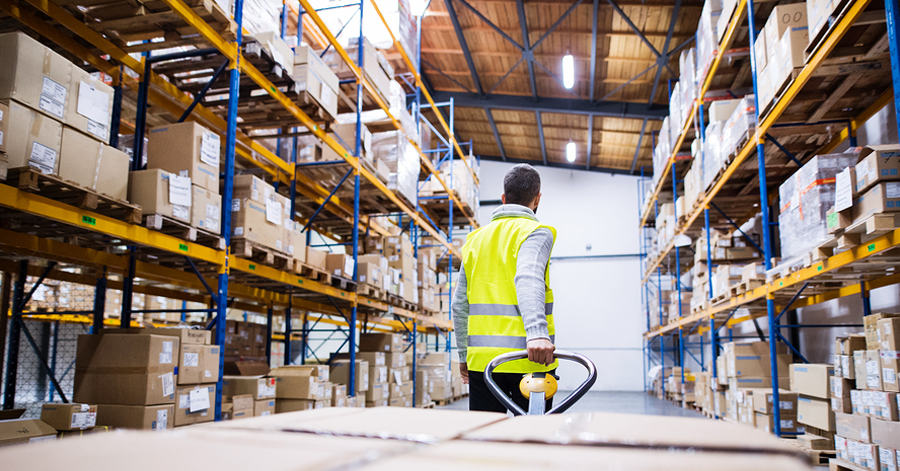
Any warehouse operator would agree, warehouse safety best practices are crucially important. Warehouse safety best practices aren't just important for the continued health of your employees — but the sustainability and growth of your business.
And while it's impossible to predict 100% of all accidents — we're only human, after all —it is possible to drastically reduce the likeliness of occurrences of accidents and injuries. Continue reading for a few simple, but highly effective warehouse safety best practices.
Warehouse Safety Best Practices Start with Cleanliness
You know the adage, "cleanliness is next to godliness," and it's also essential to preventing accidents in a warehouse. A wet or messy floor can cause slips and falls. And with a staggering 15% of all accidental deaths being caused by slips, trips, and falls — it's imperative for everyone to take ownership of workplace safety and see that spills are cleaned up as quickly as possible.
Keeping Signs Clean
Even keeping safety signs clean has two benefits: firstly, they do the job they intended, which is to be a visible safety resource; but also, studies show that clean signs are more likely to be respected (and their listed rules obeyed) than filthy or aged signs.
Keep the Warehouse Well Lit
Warehouse lighting does more to help avoid accidents than many people realize. Accidents happen most when people don't see them, and don't know to avoid them. A poorly lit environment has a much higher probability of accident occurrence.
For example, liquid spills on the floor are much more visible in well-lit environments because it reflects more light. Also, objects on which someone could trip would be more easily seen, and thus more easily avoided. A few warehouse lighting tips include:
Proper warehouse illumination is crucial to preventing accidents.
Stack Items Smartly
According to the Bureau of Labor Statistics, over 50,000 employees are struck by falling objects every year. This represents one injury every 10 minutes caused by a falling objects. However, avoiding falling objects can be avoided by proper stacking, avoiding imbalance, and employee training.
It's very important that every employee who puts anything on any shelf, either by hand or with mechanized assistance, knows the proper stacking techniques. Proper stacking, especially on higher shelves, can mean the difference between life and death.
Use Proper Lifting Techniques
Lifting heavy items is one of the most prevalent causes of workplace injuries. In 2001, the Bureau of Labor Statistics reported that more than 36% of injuries leading to missed workdays were the direct result of back and shoulder injuries.
Because of this, it's vital to train all staff on proper lifting techniques. Back injuries can easily occur with improper lifting, either from on the ground or while trying to reach a higher shelf. No dirty floor, no poorly lit hall, no falling objects create this injury, and an easily-avoided injury can have life-altering consequences for the employee.
Help Prevent Human Errors
Help your staff avoid slips and falls by adding the proper safety controls, such as:
You can't stop people from making mistakes, but you can certainly reduce the number of warehouse accidents and diminish the severity of injuries by ensuring every opportunity to raise safety is taken.
Personal Protective Equipment
Another way you can help prevent human errors is to require appropriate safety equipment for all tasks. Safety equipment exists to prevent injury, and failing to use the equipment raises the probability of injury. Do not allow any employees to raise that probability.
Promote a Culture of Safety
The best way to ensure all safety equipment is used, all lights are maintained, the warehouse is kept clean, and all proper stacking and lifting techniques are employed, is to promote a culture of safety throughout the company.
Create definable, measurable safety standards for your staff as well. Rules tend to be broken when employees don't understand them, or don't feel that benchmarks are achievable. You should also work to reward good safety behavior.
This keeps individuals motivated to follow safety standards. It also helps ensure your staff feels comfortable regulating their coworkers on proper safety techniques and behaviors, so they can manage themselves on safety and prevent accidents from occurring.
Contact PSP for Warehouse Safety Best Practices
When it comes to creating a culture of safety, Premier Safety Partners is your ally. We bring decades of experience in helping warehouse managers and owners get the most from their workforce. In most instances, increasing productivity starts by taking care of your employee's most basic needs — including safety. And once your employees know you care about their wellbeing, they'll be more likely to go above and beyond for the company.
Contact Premier Safety Partners today for a free health and safety consultation.





